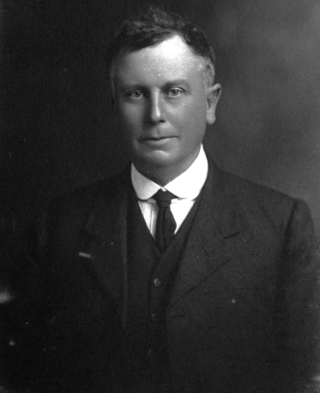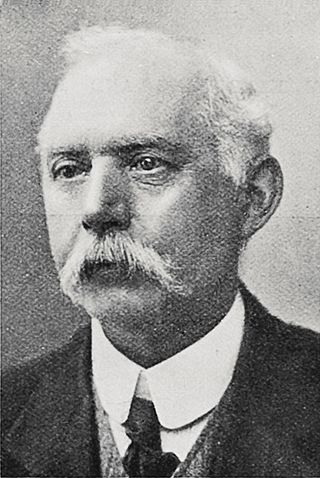The New Zealand Labour Party, or simply Labour, is a centre-left political party in New Zealand. The party's platform programme describes its founding principle as democratic socialism, while observers describe Labour as social-democratic and pragmatic in practice. The party participates in the international Progressive Alliance. It is one of two major political parties in New Zealand, alongside its traditional rival, the National Party.
The United Party of New Zealand, a party formed out of the remnants of the Liberal Party, formed a government between 1928 and 1935, and in 1936 merged with the Reform Party to establish the National Party.

Sir Thomas Mackenzie was a Scottish-born New Zealand politician and explorer who briefly served as the 18th prime minister of New Zealand in 1912, and later served as New Zealand High Commissioner in London.

In New Zealand, the Leader of the Opposition is a senior politician who leads the Official Opposition. The Leader of the Opposition is, by convention, the leader of the largest political party in the House of Representatives that is not in government. This is usually the parliamentary leader of the second-largest caucus in the House of Representatives.
The United Labour Party (ULP) of New Zealand was an early left-wing political party. Founded in 1912, it represented the more moderate wing of the labour movement. In 1916 it joined with other political groups to establish the modern Labour Party.
The Country Party of New Zealand was a political party which appealed to rural voters. It was represented in Parliament from 1928 to 1938. Its policies were a mixture of rural advocacy and social credit theory.
The Independent Political Labour League (IPLL) was a small New Zealand political party. It was the second organised political party to win a seat in the House of Representatives, and was a forerunner of the modern Labour Party.

The original New Zealand Labour Party was a short-lived left-wing political party in New Zealand. It is a predecessor of the modern Labour Party.

Alfred Humphrey Hindmarsh was a New Zealand politician, lawyer and unionist. He died in the 1918 influenza epidemic. He served as the first leader of the modern New Zealand Labour Party.
A rump party is a political party that is formed by the remaining body of supporters and leaders who do not support a breakaway group who merge with or form another new party. The rump party can have the name of the original party, or a new name.

Andrew Walker was a New Zealand politician of the United Labour Party and then the Labour Party from Dunedin.

William Edward Parry was a New Zealand Minister and trade unionist.

Elijah John "Jack" Carey was a New Zealand waiter, trade unionist and soldier.

The temperance movement in New Zealand originated as a social movement in the late-19th century. In general, the temperance movement aims at curbing the consumption of alcohol. Although it met with local success, it narrowly failed to impose national prohibition on a number of occasions in the early-20th century. Temperance organisations remain active in New Zealand today.
The New Zealand Labour Party leadership election, 1919 was held on 27 August 1919 to choose the next leader of the New Zealand Labour Party. The election was won by Grey MP Harry Holland.
The New Zealand Liberal Party leadership election 1912 was held on 22 March to choose the next leader of the New Zealand Liberal Party. The election was won by Thomas Mackenzie, who succeeded Joseph Ward.

The Lee affair was an event that transpired in the late 1930s in New Zealand revolving around the unequivocally socialist Labour Party MP John A. Lee, and his repeated public critiquing of his party's leadership. The affair culminated with Lee's expulsion from the Labour Party. Lee then formed his own political party, the further-left Democratic Labour Party, causing a sizeable rift in party membership. The events have been described as the Labour Party's first major crisis of identity, the nature of which and manner of its resolution significantly affecting the subsequent development of the party for decades. Lee's biographer Erik Olssen stated that the Lee Affair "marked a key battle in the triumph of authority over democracy."

In April 1912 and July 1913, two "unity conferences" were held to discuss and determine the future of organised labour in New Zealand. The events mainly centred around the debate over whether industrial action or political activity should be the means of achieving the aims of workers and additionally to unite the "moderate" and "militant" factions within the labour movement. Whilst neither conference fully unified the labour movement, it laid a framework of co-operation that would later assist during the creation of the current New Zealand Labour Party in 1916.
The Third Fox Ministry was a responsible government which held power in New Zealand from June 1869 to September 1872. Although William Fox was the head of the government, he was never appointed Premier as that office had yet to be established, although he did resign the office at the end of his tenure. The Ministry was also known as the Fox-Vogel Ministry as most of the agenda was set by the Treasurer, while Fox busied himself with administrative affairs and moral crusades such as the attempted introduction of local option polls for liquor licensing.










